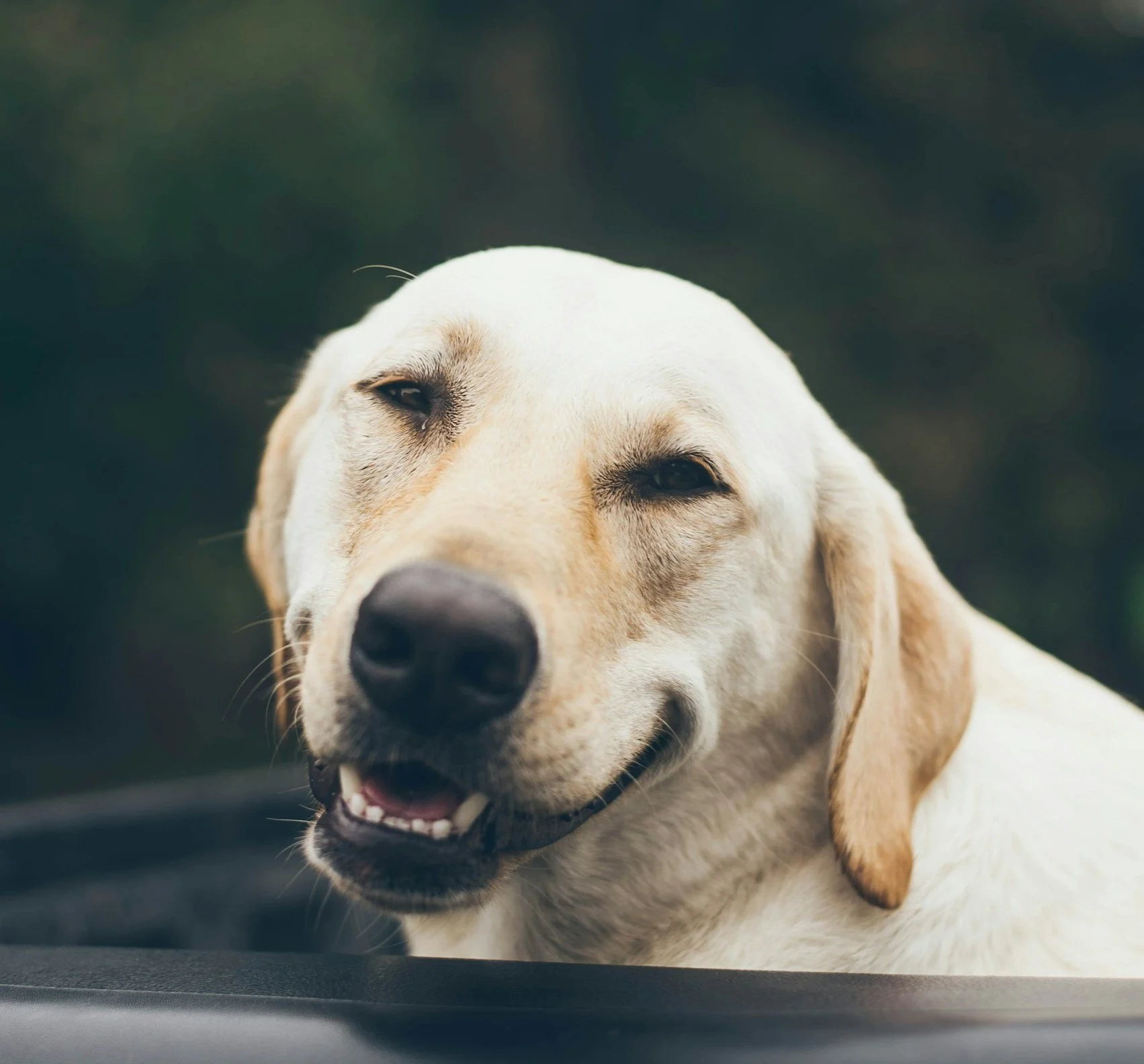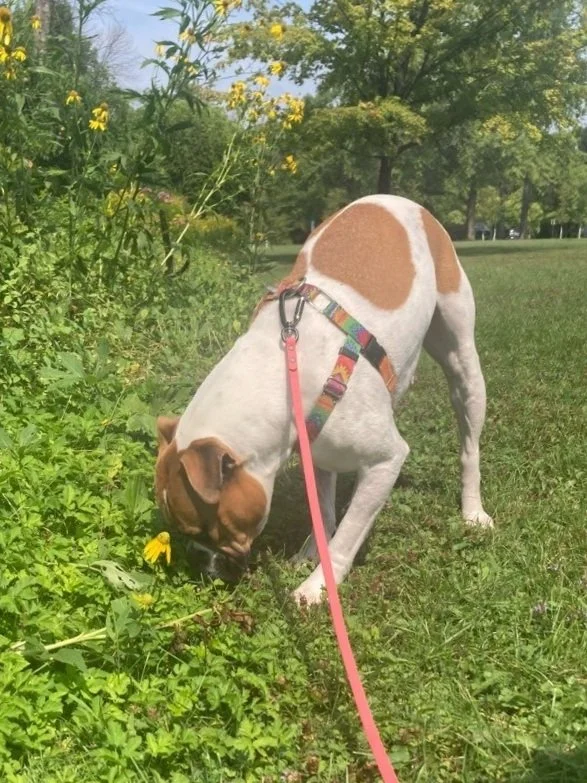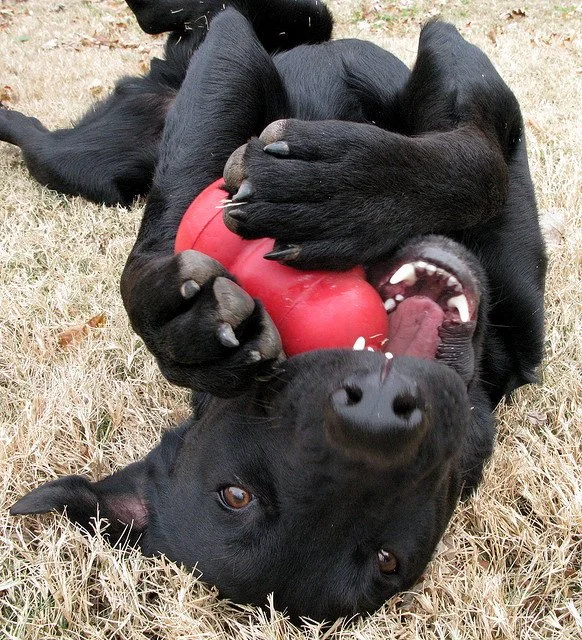Welcome back to the Unleashed Blog! I’m Marsha and I’ll be talking all about the trifecta of calm in this post. As dog owners, we've all faced those moments when our furry friends seem full of boundless energy, unable to sit still or relax. Whether it's an excitable pup that can't settle down after a walk or an anxious dog barking and pacing to cope with changes or disturbances in their environment, finding ways to help our dogs achieve calmness can be challenging. That's where the trifecta of calm protocol comes into play.
The trifecta of calm is a simple yet highly effective approach that leverages three natural behaviors—sniffing, licking, and chewing—to help dogs self-soothe and maintain balance. These activities are not just enjoyable for dogs; they also play a crucial role in reducing stress and promoting relaxation.
In this post, we'll explore the trifecta of calm protocol in detail, discussing how each element—sniffing, licking, and chewing—contributes to your dog's overall well-being. By the end, you'll have practical tips and ideas to incorporate these activities into your dog's daily routine, helping them stay calm and content.
What is the Trifecta of Calm?
Dogs are naturally inclined to engage in behaviors that help them manage stress and find calmness. The trifecta of calm protocol focuses on three key activities that tap into these instincts: sniffing, licking, and chewing. Each of these behaviors serves a unique purpose in helping dogs soothe themselves and maintain emotional balance.
Sniffing: Sniffing is a fundamental part of a dog’s daily life. It provides mental stimulation, engages their natural instincts, and helps them understand their environment. When a dog sniffs, they are not just gathering information; they are also engaging their brain in a way that can be incredibly calming. This is why you might notice your dog seeming more relaxed after a good sniffing session during a walk.
Licking: Licking is another natural behavior that dogs use to calm themselves. Whether it's licking their paws, a toy, or a lick mat smeared with peanut butter, this activity can have a soothing effect, similar to how humans might find comfort in repetitive actions. Licking releases endorphins, the feel-good hormones, which help reduce stress and anxiety.
Chewing: Chewing is a powerful stress reliever for dogs. It's not just about keeping their jaws busy; chewing actually triggers the release of calming hormones that help your dog relax. Providing appropriate chew toys or natural chews can keep your dog occupied while also helping them stay calm and satisfied.
These three behaviors—sniffing, licking, and chewing—form the core of the trifecta of calm protocol. By understanding and encouraging these activities, you can help your dog manage their energy levels, reduce anxiety, and maintain a calm demeanor throughout the day.
Sniffing
Sniffing is more than just a way for dogs to explore their environment—it's a powerful tool for mental stimulation and relaxation. When a dog sniffs, they're engaging in one of their most primal instincts. Their sense of smell is their primary way of interpreting the world, and allowing them to use it fully can have significant calming effects.
Importance of Sniffing
For dogs, sniffing is akin to how humans might read a book or solve a puzzle. It requires focus and concentration, which can tire them out mentally, leading to a calmer state. This is why sniffing is often referred to as "mental exercise" for dogs. When dogs engage in prolonged sniffing, they are not just gathering information; they're also working their brain in a way that helps expend energy and reduce anxiety.
Incorporating Sniffing into Daily Routine
To maximize the benefits of sniffing, it’s important to incorporate it into your dog’s daily routine. Here are a few ways to do that:
Scent Walks: Instead of focusing solely on physical exercise during walks, allow your dog to take the lead and explore through their nose. Let them sniff around as much as they like, even if it means a slower pace. These “sniffaris” can be more mentally satisfying for your dog than a brisk walk.
Nose Work Games: Nose work is a sport that involves training dogs to find specific scents. You can start simple at home by hiding treats or toys around the house and encouraging your dog to find them. This activity taps into their natural hunting instincts and provides excellent mental stimulation.
Scent Enrichment Activities: Use tools like snuffle mats, which are designed to hide treats within fabric strips, forcing your dog to use their nose to find them. This not only keeps them engaged but also promotes calm behavior.
Benefits of Sniffing
Regular sniffing activities can do wonders for a dog’s mental health. They help reduce anxiety, especially in high-stress situations or unfamiliar environments. Dogs who engage in sniffing activities tend to be more relaxed, less prone to destructive behaviors, and overall happier. Incorporating sniffing into your dog’s routine can be an easy yet effective way to promote calmness and well-being.
Licking
Licking is another natural behavior that plays a critical role in helping dogs self-soothe. Whether it's licking their paws, a toy, or even you, this repetitive action can have a calming effect on dogs, similar to how certain repetitive activities can be soothing for humans.
Why Licking is Calming?
Licking is a self-soothing behavior that dates back to when dogs were puppies. It mimics the comfort they felt when nursing from their mothers, which is why licking can release endorphins, the hormones responsible for feelings of pleasure and relaxation. This makes licking an effective way for dogs to calm themselves during moments of stress or anxiety.
Licking Activities to Try
There are several ways you can encourage your dog to engage in licking activities:
Lick Mats: These are silicone or rubber mats with grooves and ridges where you can spread soft treats like peanut butter, yogurt, or canned pumpkin. The process of licking these treats out of the mat keeps dogs occupied and has a soothing effect.
Frozen Treats: On hot days, or for a longer-lasting licking session, freeze dog-safe treats or broth in ice cube trays. Your dog will enjoy licking and gnawing at the frozen treats, which also helps to keep them cool.
Safe Chews and Bones: While primarily used for chewing, certain bones and chews encourage dogs to lick as they gnaw on them. This combination of licking and chewing can significantly reduce stress and keep them entertained for extended periods.
Real-Life Examples
Many dog owners have observed significant improvements in their dog’s behavior by incorporating licking activities into their routine. For instance, dogs that tend to be anxious during thunderstorms or fireworks can benefit from a lick mat to distract and calm them. Similarly, giving a dog a frozen treat during a stressful car ride can help ease their nerves and make the journey more pleasant.
Chewing
Chewing is a fundamental activity for dogs, serving both as a form of entertainment and a powerful tool for stress relief. When dogs chew, they engage their jaws and minds in a focused task that can significantly reduce anxiety and promote calmness.
The Calming Power of Chewing
Chewing is a natural behavior that dogs are inclined to do from a young age. Beyond simply keeping them busy, chewing releases endorphins—the same hormones that create a sense of pleasure and relaxation during licking. This is why providing appropriate chew items can be an excellent way to help dogs manage stress, especially during times when they might feel anxious or overwhelmed.
Recommended Chewing Options
To maximize the calming benefits of chewing, it’s important to provide your dog with safe and satisfying options that match their chewing style and preferences. Here are a few recommendations:
Durable Chew Toys: Look for high-quality, durable chew toys designed to withstand heavy chewing. Toys made from tough rubber, such as Kong toys, can be stuffed with treats or even frozen to create a long-lasting challenge that engages both the mouth and mind.
Natural Chews: Items like bully sticks, antlers, and rawhide alternatives (such as beef tendons or yak milk chews) are excellent for dogs that enjoy a more natural chewing experience. These chews not only satisfy their instinct to chew but also help clean their teeth and promote dental health.
Interactive Chews: Toys that combine chewing with mental stimulation, like treat-dispensing toys, can provide double the benefit. These toys require your dog to work for their reward, keeping them engaged for longer periods and providing both mental and physical stimulation.
Tailoring Chews to Your Dog
It’s important to choose chews that are appropriate for your dog’s size, breed, and chewing habits. For instance, a large breed dog with strong jaws will need a more durable chew than a small breed dog with a gentler bite. Additionally, always supervise your dog with new chews to ensure they are safe and to prevent any choking hazards.
Integrating the Trifecta into Daily Life
Now that you understand the components of the trifecta of calm protocol—sniffing, licking, and chewing—it's time to think about how to integrate these activities into your dog’s daily life. By doing so, you’ll help them achieve a state of calm and contentment, making life more enjoyable for both of you.
Creating a Routine
Start by incorporating these activities into your dog’s daily routine. For example, begin your day with a relaxed sniffing walk, offer a lick mat during mid-day when your dog might need some quiet time, and provide a chew toy in the evening to help them wind down before bed. Consistency is key, so try to stick to a regular schedule that your dog can anticipate and look forward to.
Observing the Effects
As you introduce these calming activities, pay attention to how your dog responds. You may notice that they become more relaxed, less anxious, and more able to settle down in different situations. Keep track of any positive changes in their behavior, as this can help you fine-tune their routine to best meet their needs.
Adjusting Based on Needs
Every dog is unique, so it's important to adjust the trifecta activities based on your dog’s individual needs. If your dog seems to prefer one activity over another, feel free to focus more on that aspect of the protocol. Similarly, if you notice that a particular activity is especially effective in reducing stress during specific situations—such as car rides or visits to the vet—make a note to incorporate that activity during those times.
Conclusion
The trifecta of calm protocol—sniffing, licking, and chewing—is a simple yet highly effective approach to helping your dog achieve and maintain a state of calmness. By understanding and incorporating these natural behaviors into your dog’s daily routine, you can reduce their anxiety, prevent destructive behaviors, and promote overall well-being.
At Off Leash MKE, we believe in using positive reinforcement and natural behaviors to help dogs live their best lives. Whether you’re a current client, a potential client, or one of our dedicated team members, we encourage you to try out the trifecta of calm protocol with your dogs. You might be surprised at how much of a difference these activities can make.
Remember, a calm dog is a happy dog—and a happy dog makes for a happy household. If you need further guidance or support, our team at Off Leash MKE is here to help with personalized service and professional dog walking designed to meet your dog’s unique needs.
For more information ideas on helping your dog find their calm, check out our past posts on DIY Dog Decompression, Fun and Enriching Indoor Activities, and Developing Self-Regulation in Your Dog








Meet Lindsey, one of the passionate pet pros behind Off Leash MKE! From helping shy dogs build confidence to sharing her favorite enrichment tips, Lindsey brings heart, knowledge, and a whole lot of love to every visit. Get to know her in this month’s Behind the Leash feature!